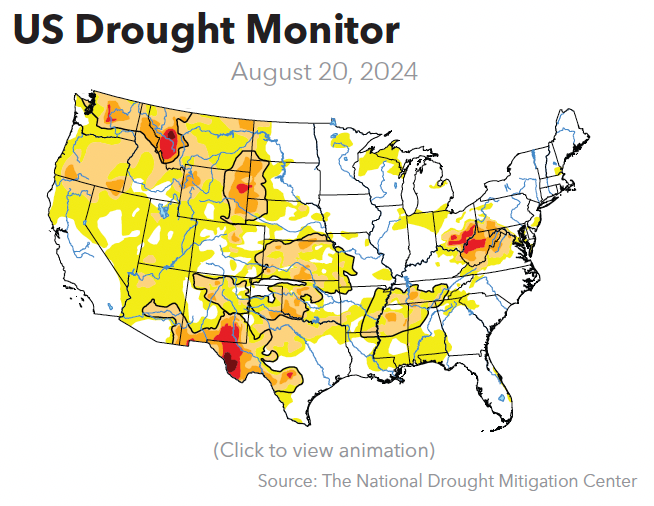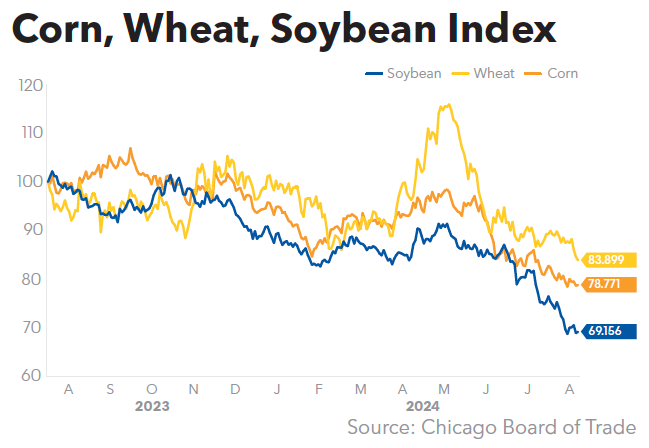Eastern Cornbelt:
After an unseasonably cool week, hot and humid weather was expected to return to the Eastern Cornbelt by the coming weekend.
Highs in northern Illinois struggled to touch the 80-degree mark at midweek, but were expected to reach 87 on Aug. 24, 90 on Aug. 25, and as high as 95 on Aug. 26, with weekend heat index values climbing to the low triple digits.
Indiana was bracing for a similar forecast, with highs in Indianapolis climbing from 77 degrees on Aug. 21 to an expected 94 degrees on Aug. 26. Ohio saw highs top out in upper-60s early in the week, but hot, muggy weather was on tap for the weekend.
USDA on Aug. 18 rated 70-76% of the corn and soybeans in Illinois as good or excellent, along with 72-73% of the acreage in Indiana, 56-57% in Ohio, and 60-71% in Michigan.
Western Cornbelt:
Temperatures across Iowa were expected to climb from the upper-70s at midweek to the mid-90s by the weekend, with heat indices reaching 105-108 degrees across much of the state by Aug. 25.
A severe thunderstorm watch was in effect for much of northern and central Nebraska early in the week, while scattered showers were reported in the state for the balance of the week. Temperatures across Nebraska were expected to soar into the high-90s by the weekend.
Similar conditions were reported in Northern Missouri, with scattered showers and midweek highs in the 80s giving way to intense heat by the weekend, when temperatures were expected to hit the low- to mid-90s and heat index levels tipping into the triple digits.
Good or excellent ratings assigned were assigned to 79-80% of the corn and soybeans in Missouri on Aug. 18, compared with 77% in Iowa and 72-74% in Nebraska. Missouri’s rice crop and cotton were 73% and 55% good or excellent, respectively, while 74% of Nebraska’s sorghum crop fell into those two categories on Aug. 18.
Northern Plains:
Forecasts warned of potentially strong thunderstorms in northwestern North Dakota at midweek, including the possibility of damaging winds and large hail.
Showers were also reported in Minnesota as the week progressed, but much warmer weather was on tap for the coming weekend, with highs expected to reach the mid-80s and low-90s, accompanied by high humidity.
The combination of heat and moisture contributed to favorable crop conditions in the region in mid-August, with good or excellent ratings assigned to 68-80% of the corn and soybeans in South Dakota, 61-64% in Minnesota, and 57-67% in North Dakota. South Dakota’s sorghum crop was 69% good or excellent as of Aug. 18.
The small grains harvest was progressing rapidly in the region. South Dakota growers had 91% of the oats in the bin on Aug. 18, compared with 56% in Minnesota and 24% in North Dakota. The spring wheat harvest was 70% complete in South Dakota, 31% in Minnesota, and 21% in North Dakota, while 30% of the barley was in the bin in Minnesota and North Dakota.
USDA rated 80-87% of Minnesota’s spring wheat and barley as good or excellent at mid-month, compared with 80% in South Dakota and 73-78% in North Dakota.
Northeast:
Spotty showers moved through the Northeast early in the week, followed by mostly dry weather and pleasant temperatures in the 70s. Much warmer weather was in the weekend forecast, however. Crop conditions remained generally favorable in the region in mid-August, with 55% of Pennsylvania’s corn crop rated as good or excellent.

